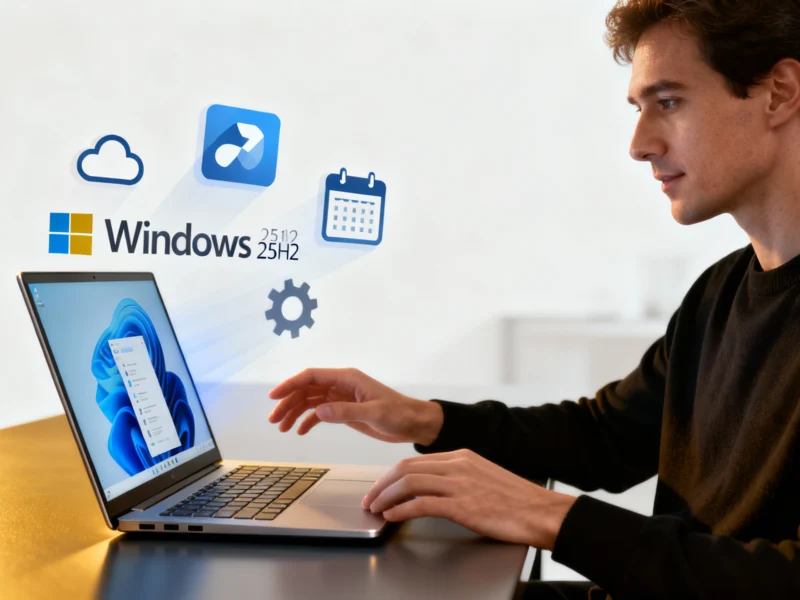Microsoft has launched Windows 11 version 25H2, delivering significant feature enhancements while maintaining the same hardware requirements as its predecessor. The update began rolling out September 30 as an enablement package that activates pre-loaded features in existing 24H2 installations, requiring minimal installation time and reducing system downtime by approximately 40% compared to traditional upgrades.
Revolutionized Start Menu and Personalization
The redesigned Start menu represents the most visible change in Windows 11 25H2, featuring pinned applications at the top, recommended content in the middle, and the complete app list below. Users can toggle between three display modes: category view, compact grid, or classic list. Microsoft has enhanced personalization options, allowing users to display more pinned apps by default or completely hide recommendations.
Business environments benefit from the preserved basic structure, minimizing documentation and training adjustments. However, limitations remain: categories cannot be renamed or created, drag-and-drop functionality only works from “All” to “Pinned” sections, and touch navigation lacks swipe-up gestures. The update also enables system folders like Settings and File Explorer as fixed icons in the bottom bar for quick access to frequently used functions.
According to Microsoft’s Windows Insider blog, the new Start menu design focuses on productivity while maintaining familiarity. The company states this approach “balances innovation with consistency” for both consumer and enterprise users.
Enhanced Phone Integration and Lock Screen Widgets
Windows 11 25H2 deepens smartphone integration through Start menu incorporation of Phone Link, enabling seamless file transfers between PC and mobile devices via drag-and-drop. Users can send images directly from File Explorer to their phones or access messages and content directly from the Start menu. Setup requires a Microsoft account for the Phone Link app but not for Windows login.
The implementation demonstrates improved stability compared to pre-release versions, with content synchronization available through local networks or mobile data connections. For businesses, this facilitates straightforward service device integration, while households benefit from simplified media management across devices.
Lock screen enhancements include expandable widgets for weather, stock prices, countdown timers, and custom information sources. The new “Discover widgets” feature suggests available widgets, streamlining customization. Microsoft’s documentation notes that current implementations require restart for changes to take effect, though this limitation may be addressed in future updates.
Advanced Recovery and Security Improvements
Windows 11 25H2 introduces “Quick Machine Recovery,” an extended self-repair function building upon Windows Recovery Environment. The system automatically detects repeated boot errors, establishes network connections, and searches for corrections via Windows Update. Administrators can configure the process for completely automated operation or manual intervention.
Activation occurs locally via Reagentc configuration or centrally through Intune policies, with predefined parameters for wait times, restart intervals, and even WiFi credentials for devices without LAN connections. Home editions feature cloud-supported repair enabled by default, while Pro and Enterprise environments require specific activation.
Security enhancements include revised data protection dialogues offering greater transparency when applications access system functions. An additional protection mechanism prevents unauthorized system changes, providing an extra security layer without third-party solutions. According to Microsoft’s Tech Community, these improvements address enterprise security concerns while maintaining user accessibility.
Performance Optimization and Enterprise Features
The update introduces CPU throttling during idle phases to reduce power consumption and extend battery life, particularly beneficial for mobile devices and notebooks. Windows automatically records diagnostic data during system slowdowns, storing logs locally at “%systemRoot%\Temp\DiagOutputDir\Whesvc” and transmitting them via Feedback Hub when activated.
File Explorer enhancements include person icons in the “Recommended” area under the “Activity” column, displaying who recently worked on files—though this feature only functions with business or school accounts. Search options remove the direct Bing search history link, centralizing access through the data protection dashboard to reduce redundant menu items.
Driver signing requirements now mandate CodeQL scans for all kernel-mode drivers (except graphics drivers) before WHCP certification. Microsoft’s driver documentation confirms this early analysis uncovers potential errors and security gaps, forcing manufacturers to address issues before driver release. The result: more stable systems with reduced crash and incompatibility rates.
Accessibility and Interface Refinements
Copilot PCs with NPU capabilities gain new functions including image descriptions for screen readers, live subtitles with translation options, and intelligent text actions in “Click to Do.” The latter enables context-dependent text processing, such as recognizing and automatically processing specific entries. The search field removal from “Click to Do’s” top bar simplifies the interface.
Users report extended initial loading times after model or build updates, a consideration for corporate rollouts. New dictionary customization allows adding custom words, benefiting both individual writers and businesses with industry-specific terminology. Taskbar scaling improvements better accommodate different display sizes and DPI settings, while Explorer context menus receive optimization with additional sharing options.
Voice Access development continues with expanded Chinese and Japanese support. Privacy settings now display which applications access Windows generative AI models, though full functionality activates in later updates. Microsoft has addressed multiple bugs, including truncated notification center content and dbgcore.dll issues causing application crashes.
References and Additional Information
For detailed technical specifications, consult Microsoft’s Windows release health documentation. Enterprise administrators can reference the Windows IT Pro Blog for deployment guidance. Independent analysis from PCWorld provides third-party perspective on performance impacts and user experience.
Microsoft maintains its commitment to stability with 25H2, building upon the shared servicing branch approach used in previous upgrades. The enablement package structure allows businesses to test new functions without recertifying entire system environments. Users can uninstall the package to revert to 24H2 functionality without operating system reinstallation.



